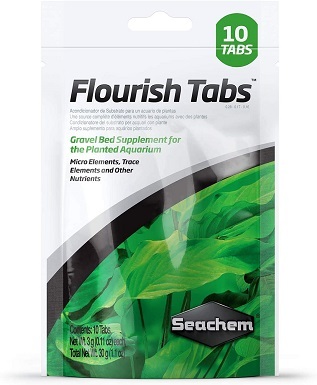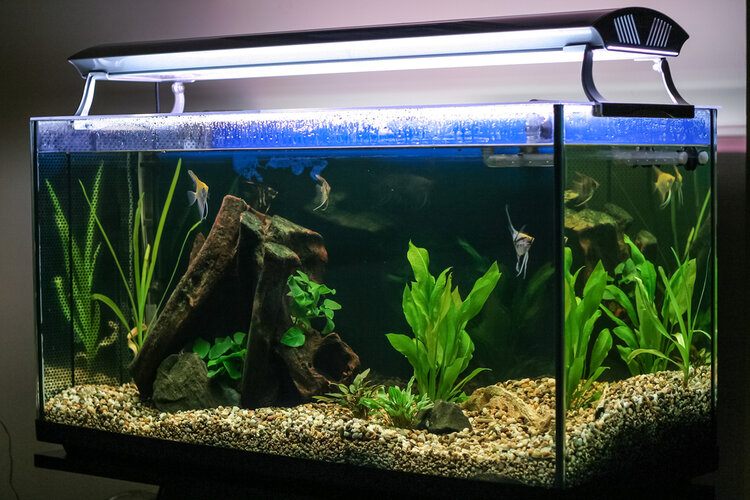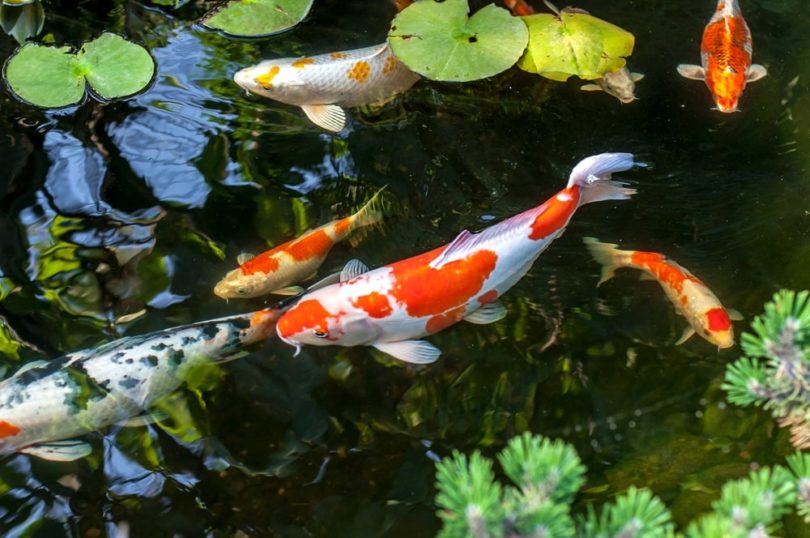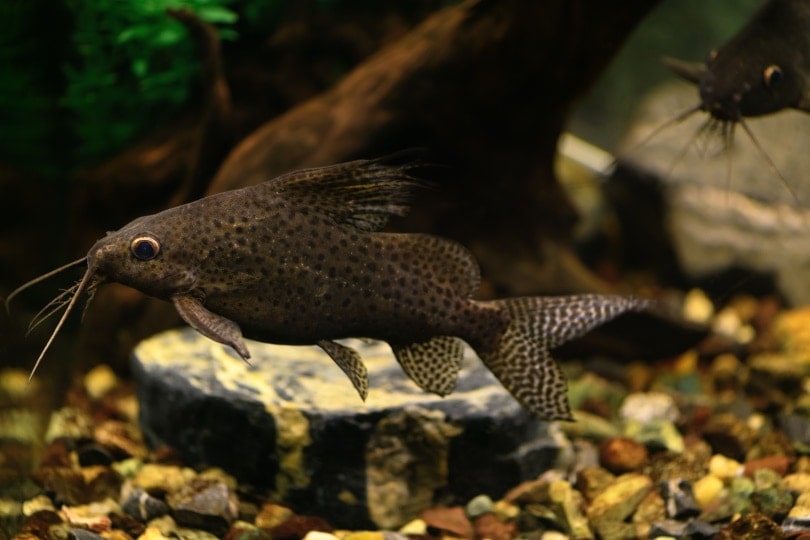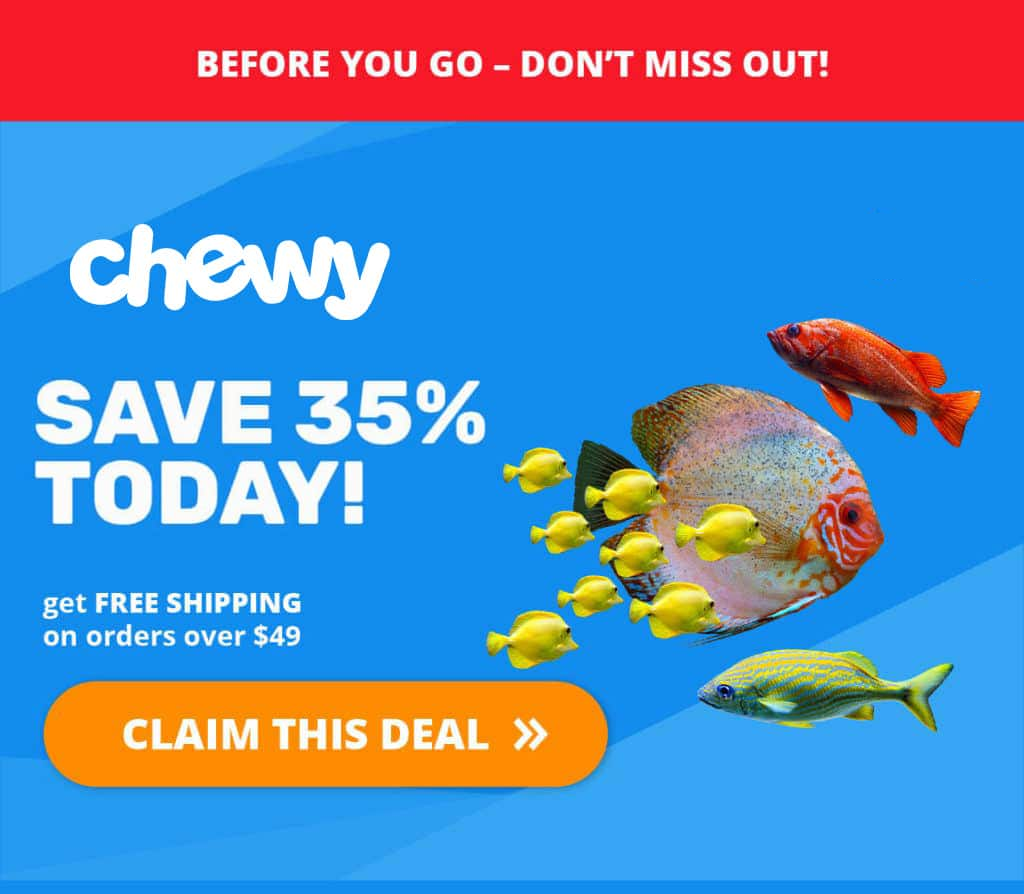6 Best Aquarium Plant Fertilizers in 2024 – Reviews & Top Picks

Updated on
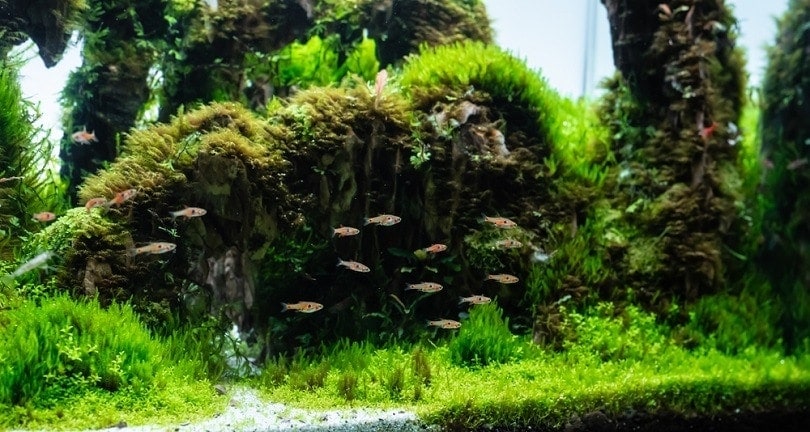
Have you ever seen an aquarium full of lush, healthy plants and thought you could never pull it off? Well, you’re in luck! Creating a full, planted tank is not as complicated and intimidating as it seems. You only need light, time, and a solid aquarium plant fertilizer.
These reviews of the 6 best aquarium plant fertilizers will help you find one that will work perfectly in your tank, helping you create the lushly planted tank of your dreams.
If you have goldfish, cichlids, or even dojo loaches, you may have to get creative to keep plants safe long enough to grow, but providing a fertilizer that is appropriate for your plants will help you achieve this. The first step is identifying whether your plants can pull nutrients from the water column or the substrate so you know if you need liquid fertilizer or root tabs.
There are aquarium plant fertilizer options available for indoor and outdoor use and for water column and root feeder plants, so you have several great options for aquarium plant fertilizers, no matter the setup of your tank or pond.
A Comparison of Our Favorites of 2024
| Rating | Image | Product | Details | |
|---|---|---|---|---|
| Best Overall |

|
Flourish Freshwater Plant Supplement |
|
Check Price |
| Best Value |

|
API Leaf Zone Freshwater Aquarium Plant Fertilizer |
|
Check Price |
| Premium Choice |

|
NilocG Aquatics Aquarium Fertilizer Shrimp Specific ThriveS |
|
Check Price |

|
Flourish Tabs Growth Supplement |
|
Check Price | |

|
API ROOT TABS Freshwater Aquarium Plant Fertilizer |
|
Check Price |
The 6 Best Aquarium Plant Fertilizers
1. Flourish Freshwater Plant Supplement – Best Overall
The Flourish Freshwater Plant Supplement is the best overall aquarium plant fertilizer because it’s durable and reliable. This supplement is made by Seachem, which is a trusted name in the aquatics community. It is available in five sizes from 50-1000 milliliters. The Flourish fertilizer includes the necessary minerals, nutrients, and phytohormones to bring out the best growth in your aquarium plants.
Phytohormones are important for regulating plant growth, activation of shoots, stress response, and root growth. This fertilizer may help improve disease resistance and mineral absorption in your plants. Some people have even found it to work well for terrestrial plants. It contains copper, which is usually not safe for invertebrates like snails and dwarf shrimp, but if the correct amount is used, it can be safe for invertebrates because of its low percentage of copper.
The Flourish fertilizer contains iron and may oxidize with exposure to air. It is a clear formula, but with oxidization, it will turn grey or black and may stain fabric or wood, so make sure to keep it somewhere safe where it won’t get spilled.
- Available in five sizes from 50-1000ml
- Includes necessary minerals and nutrients for plants
- Includes phytohormones to improve growth
- May improve disease resistance and mineral absorption with continued use
- May work well for terrestrial plants
- Can be safe for invertebrates if dosed appropriately
- Can stain items with oxidization
- Not safe for invertebrates if overdosed
2. API Leaf Zone Freshwater Aquarium Plant Fertilizer – Best Value
The best aquarium plant fertilizer for the money is the API Leaf Zone Freshwater Aquarium Plant Fertilizer. It is cost-effective and available in 8-ounce and 16-ounce bottles. It has a measuring cup built into the cap that is easy to read and use.
API uses iron and potassium to boost the growth of your plants. Iron will help prevent yellowed leaves in your plants, and potassium will boost photosynthesis, improving color and growth. It does not include copper and is safe for shrimp, snails, and other invertebrates. The measuring cup built into the lid makes measurements for almost any tank size easy and helps prevent overdosing.
The iron in API is subject to oxidization and may stain items if allowed to oxidize. It does not include phytohormones or active nutrients or minerals other than chelated iron and potassium.
- Available in 8-ounce and 16-ounce bottles
- Measuring cup built into the cap
- Contains iron to prevent yellowing leaves
- Contains potassium to boost colors and growth
- Invertebrate-safe
- Can stain items with oxidization
- Only includes two active nutrients
3. NilocG Aquatics Aquarium Fertilizer Shrimp Specific ThriveS – Premium Choice
The premium choice for aquarium plant fertilizers is the NilocG Aquatics Aquarium Fertilizer Shrimp Specific ThriveS. NilocG has multiple products in their Thrive line, but ThriveS is specifically formulated for use in shrimp tanks. It is available in 500-milliliter, 200-milliliter, and 4000-milliliter sizes. One 500-milliliter bottle can treat 2,500 gallons of water.
This fertilizer features a convenient pump top, allowing you to dose based on the number of pumps instead of using messy measuring cups. It contains necessary nutrients like nitrogen, phosphate, magnesium, iron, and calcium. It does not contain copper and is made to be safe for shrimp and other invertebrates.
It can be used up to three times per week and will help boost the growth of the plants in your shrimp tank, improving shrimp health and reproduction. NilocG has iron and may stain items with oxidization. If you’re using it for a tank smaller than 5 gallons, you may need to use a syringe for dosing since one pump of this fertilizer is enough for a 5-gallon tank.
- Formulated to be safe for shrimp
- Available in three sizes from 500-4,000 milliliters
- Convenient pump top
- Includes necessary minerals and nutrients for plant growth
- Can be used up to three times per week
- Can stain items with oxidization
- Premium price
- Difficult to dose for tanks smaller than 5 gallons
4. Flourish Tabs Growth Supplement
Flourish Tabs Growth Supplement is a great product for plants that require root fertilization. It can be purchased in 10- and 40-tab count packs. The ingredients in the root tabs are very similar to the Flourish liquid supplement but are more easily absorbed by root feeder plants.
Flourish root tabs contain essential trace elements, amino acids, vitamins, and minerals to boost the growth and health of aquatic plants. They are intended to release nutrients into the substrate slowly and only need to be replaced every 3–4 months. The root tabs should not alter water parameters, but if you have very soft water, they may lower your pH slightly.
Flourish tabs should be placed approximately every 4–6 inches for maximum efficacy, and it’s recommended to use 6 tabs for every 10 gallons. They contain copper, and they may not be safe for aquariums with shrimp or other invertebrates.
- Available in 10-tab and 40-tab packs
- Contains necessary trace elements, proteins, and nutrients for growth
- Slowly release into the substrate over multiple months
- Should not alter water parameters
- Less messy than liquid fertilizers
- Should be replaced every 3–4 months
- Manufacturer recommends 6 tabs for every 10 gallons
- Contains copper and may not be safe for shrimp
5. API ROOT TABS Freshwater Aquarium Plant Fertilizer
The API ROOT TABS Freshwater Aquarium Plant Fertilizer are a good option for plants that absorb nutrients via the roots. They are only available in one size with 10 tabs. API root tabs contain essential nutrients for plants to flourish, including carbon, potassium, and iron. The tabs do not contain copper, so they are safe for most invertebrates.
They are less messy than liquid fertilizers, and even though they contain iron, there is little risk of oxidization stains. They can be placed directly into the substrate and covered with newly planted plants to help them start off strong in your tank.
It is recommended to replace API root tabs monthly for maximum efficacy. They should be placed approximately every 30 square inches or six tabs per 10 gallons. API tabs may be difficult to place without causing water cloudiness.
- Slowly release into the substrate over a month
- Contains essential nutrients for plant growth
- Invertebrate-safe formula
- Available in 10-tab packs
- Less messy than liquid fertilizers
- Should be replaced monthly
- Manufacturer recommends 6 tabs for every 10 gallons
- May be difficult to place without clouding the water
6. Winchester Gardens Highland Rim Aquatic Fertilizer
The Winchester Gardens Highland Rim Aquatic Fertilizer is a great root tab option for ponds. They are specially formulated for water lilies and lotuses but can be used for other large aquatic plants. There are 12 root tabs in a package. The root tabs are formulated with nitrogen, phosphorus, and potassium.
They help boost growth in your pond plants and may improve disease resistance. Winchester Gardens tabs are not formulated with copper, so they are intended to be safe for all aquatic life. These are made not to break apart when wet and should not cloud your water. The tabs should be replaced every 2 months throughout the spring and summer.
One of the main ingredients is phosphorus, which can enter local waterways via runoff, causing problems with water quality. Phosphorus fertilizers are illegal to purchase in some states, so it’s important to check this before purchase. They are not a great option for aquarium plants but will help improve growth in pond plants.
- 12 tabs per package
- Formulated to be safe for all aquatic life
- Will boost growth in pond plants like lotuses and water lilies
- Will not break apart or cloud water
- May help improve disease resistance in plants
- Should be replaced every 2 months
- Phosphorus may decrease local water quality
- Phosphorus fertilizers are illegal in some areas
- Not ideal for aquarium plants
- Only available in one package size
Buyer’s Guide: Selecting The Best Aquarium Plant Fertilizer
- Liquid
For plants that can pull nutrients from the water column, liquid aquarium plant fertilizers are a great option. They are dosed directly into the water and dispersed throughout the aquarium, providing nutrition to plants throughout the tank.
Liquid fertilizers may come with a pump top that allows for easy dosing, or they may come with a cap that has measuring marks in it to allow for easy dosing. This type of fertilizer is effective but can be messy. Usually, liquid fertilizers should be used one to three times per week.
- Root Tabs
Some plants cannot pull nutrients from the water column and require nutrient-rich substrate. Root tabs are an excellent way to improve the nutrient levels within your aquarium’s substrate. The pre-formed tabs are pressed directly into the substrate and covered with plants or substrate.
They do not require frequent replacement, usually only needing to be replaced every month or more. Root tabs will not be an effective form of fertilization for plants that cannot absorb enough nutrients via their roots or plants that float and do not contact the substrate.
- Substrate
As more people have begun keeping planted tanks, manufacturers have started developing aquarium substrates that are rich in the nutrients that many plants need to thrive. They are often more expensive than other types of substrates, like gravel and sand.
Over time, plants can pull most of the nutrients out of the substrate, which will require supplementation or replacement of the substrate. It’s important to check the ingredients in these substrates to ensure they are safe for all aquatic life if you intend to keep invertebrates.
- Your Plants: Different plants have different needs regarding nutrient absorption. Plants like Vallisneria, Anubias, Ludwigia, and Crypts require nutrient-rich substrates. There are plant-specific substrates you can purchase for plants like these, but those substrates are not ideal for all tanks or preferences. Root tabs are a great way to acquire enough nutrients within your aquarium’s substrate for root feeder plants. Plants like Java moss, Hornwort, Red Root Floaters, Water Lettuce, and Cabomba absorb all or most of their nutrients from the water column. For water column feeders, liquid fertilizers you add directly to the water are the perfect way for these plants to receive enough nutrients.
- Your Invertebrates: Shrimp are extremely sensitive to copper, but so are other invertebrates like crabs, snails, and crayfish. Some fertilizers that contain copper are considered safe for use with invertebrates as long as they are dosed correctly, but overdosing them can be deadly to your invertebrates. If you are uncomfortable taking the chance, copper-free fertilizers are the best option for your aquarium. If you don’t have any invertebrates in your aquarium, copper is not generally a problem. It gives you a broader selection of fertilizers to choose from.
- Your Tank: Freshwater and saltwater plants have different nutrient needs. Not all aquarium plant fertilizers are safe or approved for use in freshwater and saltwater tanks. Identifying if the fertilizer you are considering purchasing is safe to be used in your type of tank, whether freshwater or saltwater, will save you time and money in the long run.
- Your Setup: Aquarium plants and pond plants have different nutrient needs. Some plants can be used in ponds and indoor aquarium setups, like some varieties of water lilies, hornwort, and water lettuce, and will have similar needs regardless of where they are kept. Other plants are more sensitive to changes in water parameters, sunlight, or temperatures, like Crypts, Glossostigma, Riccia, and Rotala. These plants are best kept in indoor tank setups where all parameters can be closely monitored and kept in range. They have different needs than plants that are kept in outdoor environments, where they receive nutrients from rainwater, insects, fish, amphibians, and runoff from other bodies of water.
- Your Local Laws: Many fertilizers contain phosphorus, but they’re illegal to purchase in some areas due to the dangers they pose to native waterways. If you are planning on buying a phosphorus-containing fertilizer, make sure to check your local laws before you purchase. This is especially important if you intend to use the fertilizer outdoors in water gardens or ponds. If there is any chance of flooding, overflow, or runoff, fertilizers with phosphorus are not recommended.
Conclusion
Aquarium plant fertilizers are an easy way to boost the health, growth, and color of your aquarium plants. These reviews of the 6 best aquarium plant fertilizers will help you narrow your search for the perfect plant fertilizer for your aquarium’s needs. You may need to use root tabs and liquid fertilizers in your tank, depending on your plants.
The best overall pick for aquarium plant fertilizers is the Flourish Freshwater Plant Supplement because of its high level of efficacy and safety. For a more premium product, the NilocG Aquatics Aquarium Fertilizer Shrimp Specific ThriveS is a highly effective option that is safe for invertebrates like shrimp and snails. The best value product is the API Leaf Zone Freshwater Aquarium Plant Fertilizer because it’s effective but cost-effective.
Adding an aquarium plant fertilizer to your tank will boost the growth of your plants, causing people to wonder what you’re doing to achieve such fantastic results in your tank. Fertilizers are so easy to use that anyone can do it. You can leave people wondering what you’re doing to produce such beautiful plants, or you can share your secrets with your friends, helping them achieve beautiful aquarium plants as well.
Featured image credit: BLUR LIFE 1975, Shutterstock






